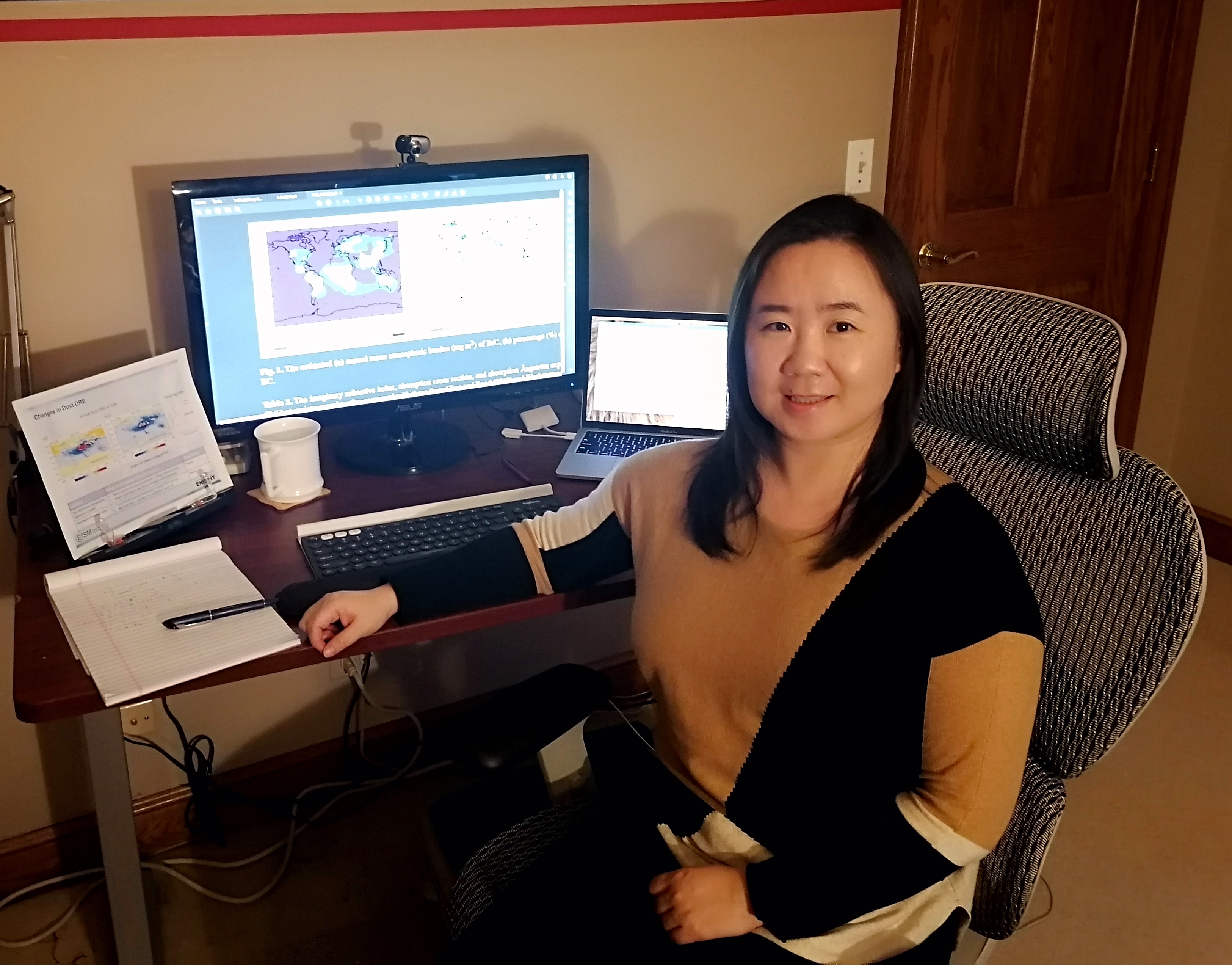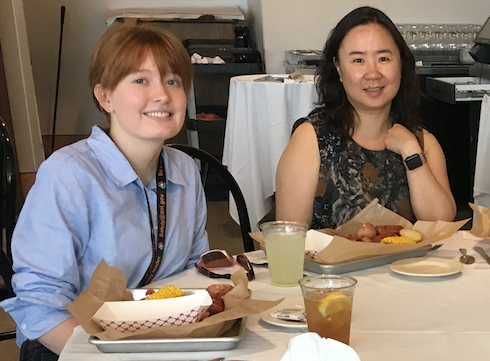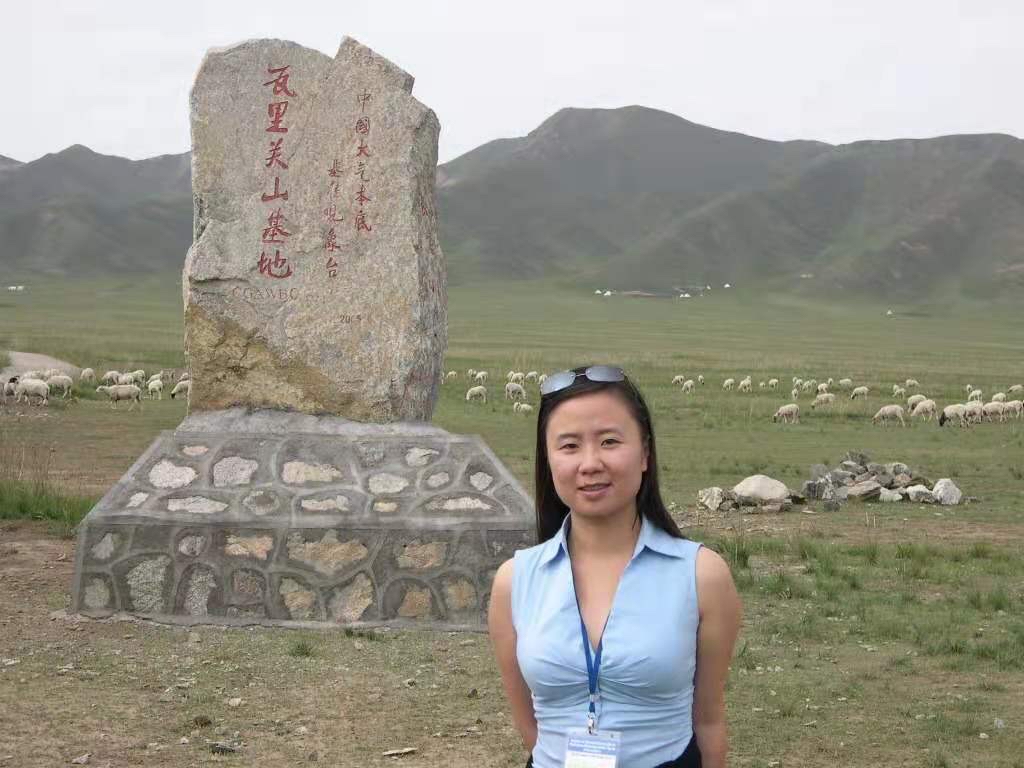A scientist employs wide arrays of data to model the tiny atmospheric particles that steer clouds and climate

Scientist Yan Feng is among a group of researchers who model the energy balance maintained by the Earth and sun.
About half of incoming solar radiation is absorbed by land and oceans. Another 40% or so is absorbed or scattered back into space by clouds and the aerosols (tiny airborne particles) that also act as cloud condensation nuclei for cloud formation.
How do these energy-balancing, life-giving clouds and aerosols interact with air pollution? With broad shifts in climate? Or with the Earth’s complex biogeochemical cycle?
Modeling these aerosol-climate interactions mathematically and predictively is the world that Feng inhabits, benefits, and expands. She is a Principal Atmospheric and Climate Scientist at Argonne National Laboratory in Illinois. A prolific author, researcher, and mentor, Feng also holds joint appointments at the University of Chicago and Northern Illinois University.
Her early work as a graduate student in the 1990s provided one of the first global distribution estimates of nitrate aerosols in the atmosphere. Feng’s three-dimensional global modeling of nitrate aerosol chemistry, highly cited from the beginning and described in several later papers, informed an early iteration of the Intergovernmental Panel on Climate Change.
Smoke and Long-Range Atmospheric Transport
“The world is a very interconnected place atmospherically, in ways most of us do not realize. We really need to look at earth systems as a whole. We are connected; we are not separated.”
— Yan Feng
Feng is currently a key investigator on a Scientific Focus Area (SFA) project supported by the U.S. Department of Energy’s Atmospheric System Research (ASR) program. Led by meteorologist and cloud-system researcher Mike Jensen at Brookhaven National Laboratory in New York, the SFA is a Brookhaven-Argonne joint effort to reduce uncertainties in regional and global climate models.
The research requires grappling with ways to accurately represent clouds, aerosols, precipitation, and other factors that drive the dynamic physics of climate systems.
Her role is to understand how biomass-burning (smoke) aerosol properties change during long-range transport in the atmosphere, “from emission to remote location,” she says, “and how they impact the radiation balance.” Along the way, Feng studies the processes that affect these “aging” (evolving) aerosols, including changes in gas-phase chemistry and cloud processes.
One recent example is a 2020 study she co-authored with Jian Wang’s group at Washington University in St. Louis. The paper looks at how smoke plumes from epic 2017 wildfires in Canada moved over great distances high in the atmosphere and descended, chemically transformed, into marine boundary layer clouds in the remote eastern North Atlantic.
The study taps a variety of data sets, including many from the Atmospheric Radiation Measurement (ARM) user facility at the U.S. Department of Energy (DOE), during ARM’s Aerosol and Cloud Experiments in the Eastern North Atlantic (ACE-ENA) field campaign. ARM supports multiple atmospheric observatories, some fixed and some mobile, in climate-critical regions around the world.
“Well-aged smoke aerosols (from biomass burning) play a major role in the cloud microphysics marine boundary layer,” says Feng, describing this research avenue as one that is just now widening.
Fires Felt Far Away

The radiative effects of smoke aerosols from biomass burning events, including wildfires and agricultural controlled burning practices, strongly depend on the evolution of aerosol properties during aging.
To illustrate, Feng has an ongoing aerosol-modeling project based on data from ARM’s Layered Atlantic Smoke Interactions with Clouds (LASIC) field campaign, which took place in 2016―2017.
During LASIC, ARM’s first Mobile Facility (AMF1) was deployed on Ascension Island in the remote southeast Atlantic Ocean to pull in data from smoke layered within vast marine cloud decks overhead. (To set the scene, go to a 2018 paper led by chief LASIC scientist Paquita Zuidema.)
The light-absorbing plumes above Ascension are replete with aerosols from seasonal forest fires and agricultural burns in Africa, the largest such sources in the world.
Feng studies black and brown carbon and other organic substances within such plumes. She says it is critical for models to accurately represent the fire-emitted aerosols and their radiative effects for climate prediction, since there is an increasing trend of wildfire potential around the world.
To date, models generally underestimate the role of aerosol absorption in regions where biomass burning is prominent. Feng and collaborators have shown in several studies that neglecting brown carbon absorption contributes to this low bias. Consequently, they have developed new parameterizations of brown carbon and have demonstrated its global radiative impacts.
There are still many uncertainties in modeling biomass plumes, including mixing state and organic aerosol chemistry. Observations like those provided by LASIC data, says Feng, provide the ground truth for model evaluation and improvement.
She also contributed to a 2020 study during the NASA ORACLES campaign that quantifies the aerosol evolution before reaching Ascension Island, the LASIC site.
E3SM on the Feng Menu

Feng’s work represents new synergies between the worlds of modeling and observation.
During a January 2021 virtual invited talk at the annual meeting of the American Meteorological Society, Feng discussed her recent work with Brookhaven atmospheric chemist and observationalist Art Sedlacek (“my closest SFA collaborator,” she says) and others on modeling aged biomass-burning aerosols constrained by the LASIC data.
“We looked at the current status of dynamically evolving biomass-burning aerosol properties,” says Feng, whose work moves from understanding data sets to developing model parameterizations.
Those parameterizations “incorporate process-level understanding into large-scale models,” she says. “While aerosols are tiny, they have global impacts that need to be quantified in earth system models.”
It is elegant, then, that the other half of Feng’s research efforts focus on model development of aerosol processes for DOE’s Energy Exascale Earth System Model (E3SM) project.
Global Nitrate Aerosol Model
The first powerful early influence who steered Feng towards modeling aerosols was atmospheric scientist Joyce Penner, who, before her university career, had led aerosol chemistry efforts at Lawrence Livermore National Laboratory in California.
Feng was one of Penner’s first graduate students at the University of Michigan (MS 2002, PhD 2005).
When Feng first arrived in 1997, “I wanted to study ozone holes,” she says. “Then I learned about aerosols, which have complicated interactions with both gas-phase chemistry and climate.”
From there, with Penner as her PhD advisor, Feng developed a computationally efficient model of nitrogen aerosol formation in a global chemistry transport model.
Fruitful Days at Scripps

After graduation, Feng headed to the University of California, San Diego’s Scripps Institution of Oceanography for postdoctoral work (2005-2010).
There she met her great professional influence, atmospheric and climate scientist Prof V. Ramanathan, a National Academy of Sciences Fellow.
At Scripps, Feng worked on modeling aerosol-cloud interaction, as in this 2010 paper, and did initial work into what are now the chief signatures of her research: brown carbon.
But it was her working with Ramanathan that, in a broad way, was most influential in her career.
“Ram is one of the few people to understand both observations and modeling,” including for studies of radiative transfer, says Feng. “He opened my eyes (beyond) the modeling world. It’s a very cool idea to combine observations and modeling.”
From her experience with two powerful mentors, Feng returned the favor by being a mentor herself. In the summer of 2019, for instance, she worked with Science Undergraduate Laboratory Internship (SULI) student Emily Brown, now a Chemical Engineering PhD student at the University of California, Berkeley.
Brown’s SULI paper on wildfire potential in the United States was published in 2021. Feng was a co-author.
East Asian Aerosols
The “cool idea” of combining observations and modeling informed Feng’s first work at Argonne National Laboratory, which she joined in 2010 as an assistant computational atmospheric scientist.
For one, she published a brown carbon paper in 2013 that is still racking up citations―about 400 so far.
“This is one of the most important works of my career, she says, which since then “has been attached to brown carbon.”

Within two years, Feng also started working with data sets streaming out of ARM’s 2011-2012 Ganges Valley Aerosol Experiment (GVAX) field campaign in India. Argonne Senior atmospheric scientist V. Rao Kotamarthi was the lead scientist.
The GVAX work, she says, marked “my first project within ASR” and led to two first-authored papers in 2016.
While working with GVAX data, Feng set up a regional climate model using WRF-CHEM to simulate how aerosols affect the radiative budget in that region of South Asia. (WRF-CHEM is short for the Weather Research and Forecasting Model coupled with Chemistry, a scheme for linking aerosol transport with meteorology.)
It was during her GVAX modeling work, while using WRF-Chem, that Feng woke to the power of the vertical distribution of aerosols.
“We used micropulse lidar (MPL) to extract and constrain vertical profiles on the extinction of aerosols,” she says. “That’s a key parameter in calculating aerosol radiative forcing.”
Feng worked with Argonne’s Richard Coulter, an ARM MPL mentor, who has since retired.
Vertical profiles continue to be a research thread Feng is still pursuing today. She uses LASIC data and works with the current MPL mentor, Argonne’s Paytsar Muradyan.
Globe-Spanning Dust. Airborne Iron Supplies
Feng is interested in carbonaceous aerosols, but also the minerals in dust aerosols.
She co-authored a 2009 paper on an experiment tracking dust outbreaks from East Asia across the Pacific into North America.
During atmospheric transport, as illustrated in her 2010 paper, insoluble aerosolized iron compounds are transformed chemically, by pollutants, into soluble iron that is then bioavailable to plankton and other biota in the world’s oceans.
In the past decade, modeling such dust iron has been one of Feng’s current deep interests.
Feng also collaborates with beamline scientists at the Argonne Advanced Photon Source to understand the mineralogical fingerprints in dust-iron particles during long-range transport.
That work informs the earth system modeling of both dust radiative effects and iron cycling.
‘We are Connected’

Feng grew up in landlocked Sichuan Province in temperate south-central China. A ring of mountains encloses the province in a basin, where rapid economic growth in the 1980s capped urban areas with a roof of seasonally compromised air.
At top-rated Peking University in Beijing (BS, 1997), Feng kept that pollution layer and its chemical mysteries in mind as she entered a bachelor’s degree program in atmospheric science.
Today, outside of science, Feng is still the avid reader she was as a girl, with a special interest in “traveling to places with a lot of history.”
She takes a long trip once a year with her husband: Prague, Rome, Paris, London, and Great Britain’s highest mountain outside the Scottish Highlands (Snowdon, in Wales), and all over China.
“I have always wondered,” says Feng, “what the world was like in history―a hundred years ago, a thousand years ago.”
She sees science itself as a form of travel, beginning with the lesson contained in the dust and aerosols that travel the world on high-altitude air currents.
“The world is a very interconnected place atmospherically, in ways most of us do not realize,” says Feng. “We really need to look at earth systems as a whole. We are connected; we are not separated.”
# # #Author: Corydon Ireland, Staff Writer, Pacific Northwest National Laboratory
This work was supported by the U.S. Department of Energy’s Office of Science, through the Biological and Environmental Research program as part of the Atmospheric System Research program.

